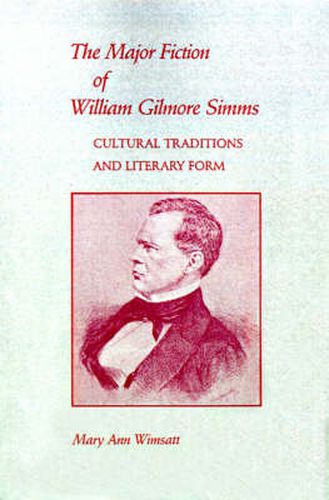Readings Newsletter
Become a Readings Member to make your shopping experience even easier.
Sign in or sign up for free!
You’re not far away from qualifying for FREE standard shipping within Australia
You’ve qualified for FREE standard shipping within Australia
The cart is loading…






This title is printed to order. This book may have been self-published. If so, we cannot guarantee the quality of the content. In the main most books will have gone through the editing process however some may not. We therefore suggest that you be aware of this before ordering this book. If in doubt check either the author or publisher’s details as we are unable to accept any returns unless they are faulty. Please contact us if you have any questions.
William Gilmore Simms (1806-1870) was the preeminent southern man of letters in the antebellum period, a prolific, talented writer in many genres and an eloquent intellectual spokesman of r his region. During his long career, he wrote plays, poetry, literary criticism, biography and history; but he is best remembered for his numerous novels and tales. Many Ann Wimsatt provides the first significant full-length evaluation of Simms’s achievement in his long fiction, selected poetry, essays, and short fiction.
Wimsatt’s chief emphasis is on the thirty-odd novels that Simms published from the mid-1830s until after the Civil War. In bringing his impressive body of work to life, she makes use of biographical and historical information and also of twentieth-century literary theories of the romance, Simm’s principal genre. Through analyses of such seminal works as Guy Rivers, The Yemassee, The Cassique of Kiawah, and Woodcraft, Wimsatt illuminates Simm’s contributions to the romance tradition, contributions misunderstood by previous critics, and suggests how to view his novels within the light of recent literary criticism. She also demonstrates how Simms used the historical conditions of southern culture as well as events of his own life to flesh out literary patterns, and she analyses his use of low-country, frontier and mountain settings.
Although critics praised Simms early in his career as
the first American novelist of the day,
the panic of 1837 and the changes in the book market that it helped foster severely damaged his prospects for wealth and fame. The financial recession, Wimsatt finds, together with shifts in literary taste, contributed to the decline of Simms’s reputation. Simms attempted to adjust to the changing climate for fiction by incorporating two modes of nineteenth-century realism, the satiric portrayal of southern manners and southern backwoods humor, into the framework of his long romances; but his accomplishments in these areas have been undervalued or misunderstood by critics since is time.
Wimsatt’s book is the first to survey Simms’s fiction and much of his other writing against the background of his life and literary career and the first to make extensive use of his immense correspondence. It is an important study of a neglected author who once served as the leafing symbol of literary activity in the South. It fills what has heretofore been a serious gap in southern literary studies.
$9.00 standard shipping within Australia
FREE standard shipping within Australia for orders over $100.00
Express & International shipping calculated at checkout
This title is printed to order. This book may have been self-published. If so, we cannot guarantee the quality of the content. In the main most books will have gone through the editing process however some may not. We therefore suggest that you be aware of this before ordering this book. If in doubt check either the author or publisher’s details as we are unable to accept any returns unless they are faulty. Please contact us if you have any questions.
William Gilmore Simms (1806-1870) was the preeminent southern man of letters in the antebellum period, a prolific, talented writer in many genres and an eloquent intellectual spokesman of r his region. During his long career, he wrote plays, poetry, literary criticism, biography and history; but he is best remembered for his numerous novels and tales. Many Ann Wimsatt provides the first significant full-length evaluation of Simms’s achievement in his long fiction, selected poetry, essays, and short fiction.
Wimsatt’s chief emphasis is on the thirty-odd novels that Simms published from the mid-1830s until after the Civil War. In bringing his impressive body of work to life, she makes use of biographical and historical information and also of twentieth-century literary theories of the romance, Simm’s principal genre. Through analyses of such seminal works as Guy Rivers, The Yemassee, The Cassique of Kiawah, and Woodcraft, Wimsatt illuminates Simm’s contributions to the romance tradition, contributions misunderstood by previous critics, and suggests how to view his novels within the light of recent literary criticism. She also demonstrates how Simms used the historical conditions of southern culture as well as events of his own life to flesh out literary patterns, and she analyses his use of low-country, frontier and mountain settings.
Although critics praised Simms early in his career as
the first American novelist of the day,
the panic of 1837 and the changes in the book market that it helped foster severely damaged his prospects for wealth and fame. The financial recession, Wimsatt finds, together with shifts in literary taste, contributed to the decline of Simms’s reputation. Simms attempted to adjust to the changing climate for fiction by incorporating two modes of nineteenth-century realism, the satiric portrayal of southern manners and southern backwoods humor, into the framework of his long romances; but his accomplishments in these areas have been undervalued or misunderstood by critics since is time.
Wimsatt’s book is the first to survey Simms’s fiction and much of his other writing against the background of his life and literary career and the first to make extensive use of his immense correspondence. It is an important study of a neglected author who once served as the leafing symbol of literary activity in the South. It fills what has heretofore been a serious gap in southern literary studies.